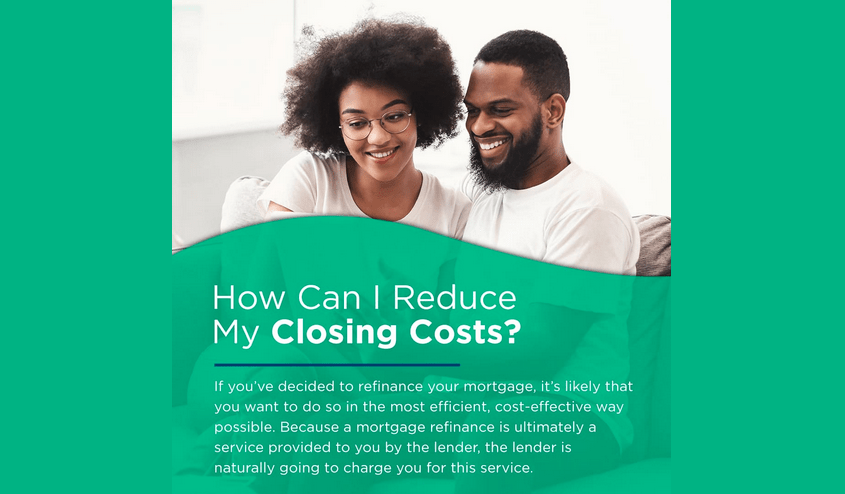Are you thinking about a no-closing-cost refinance? It may be a great idea if you don’t have enough money for closing costs or if you’d rather not use your savings. This option can also make sense if you’re planning to move soon. But remember, even though it’s called “no-closing-cost,” it’s not actually free. Make sure you understand how it works to decide if the upfront savings are worth any potential long-term expenses.
Definition: What is a no-closing-cost refinance?
A no-closing-cost refinance allows you to replace your current mortgage with a new one without paying the upfront fees. Instead, you have two options: either include the closing costs in your loan amount or let your lender cover the costs in exchange for a higher interest rate.
Even though it’s called “no-cost,” you’re essentially financing the closing costs. The lender compensates you by raising your interest rate or adding the costs to your loan. This means your monthly payments and total interest over the loan’s life will be higher compared to paying the costs upfront. If you choose to increase your loan amount, you’ll also reduce the equity in your home, potentially leading to lower proceeds when you sell it later on. The question here is: Should you refinance your mortgage?

How does no-closing-cost refinance work?
Now, for you to know how a no-closing-cost refinance works, we will examine the practical numbers. Let us compare the immediate and long-term benefits of two approaches: including $5,000 of costs into the loan amount versus incorporating them into the interest rate. This comparison involves a 30-year fixed-rate refinance for a $300,000 loan.
| Refinance with closing costs | No-closing-cost refinance with higher loan amount | No-closing-cost refinance with higher interest rate | |
|---|---|---|---|
| Loan amount | $300,000 | $305,000 | $300,000 |
| Interest rate | 6.86% | 6.86% | 7.36% |
| Monthly payment (principal and interest) | $1,967.78 | $2,000.58 | $2,068.96 |
| Total interest costs | $408,400.99 | $415,207.68 | $444,825.38 |
| Total cost paid at closing | $5,000 | $0 | $0 |
The table below shows the dollar cost and savings of each no-closing-cost option, compared to paying the closing costs with cash.
| Refinance with closing costs | No-closing-cost refinance with higher loan amount | No-closing-cost refinance with higher interest rate | |
|---|---|---|---|
| Out of pocket cost | $5,000 | $0 | $0 |
| Extra monthly payment cost | N/A | $32.80 | $101.18 |
| Extra long-term interest cost | N/A | $6,806.69 | $36,424.39 |
| Equity cost | $0 | $5,000 | $0 |
In this example, when deciding between the two no-closing-cost refinance options, consider the following points:
- If you choose the no-cost refinance with the higher interest rate results in the highest monthly payment and overall interest charges.
- Choosing the no-cost refinance with the increased loan amount leads to a lower monthly payment and total interest charges, but you’ll borrow an additional $5,000 from your home equity.
- While the refinance with closing costs incurs the highest out-of-pocket expense, it offers the lowest monthly payment and total interest charges. Additionally, you won’t tie up extra home equity through this option.
Common refinance closing costs
Mortgage refinance closing costs can vary from 2% to 6% of your loan amount, which can become significant, particularly for larger loans. For instance, if you’re refinancing a $300,000 loan and your closing costs amount to 2% of the loan, you’ll pay $6,000 in closing costs.
Typical closing costs for a standard refinance include:
- Lender charges like origination fees, fees for credit reports, and expenses for home appraisal
- Title-related expenses, including fees for title insurance and escrow
- Collection of property taxes and homeowners insurance premiums for your escrow account.
Can You Refinance a Mortgage with No Closing Costs? If you understand the calculation above, you can answer this question by yourself.
Helpful Insights
- How to Calculate Your Loan Payments with Mortgage Calculator
- Amortization Calculator – Schedule & Fixed Housing Interest Rates
- How Much is Mortgage Payments, Interest rate, Taxes and Insurance
- Steps to get Low-cost Mortgage Refinance to lower your Interest rate and Monthly Payments
No-closing-cost refinance pros and cons
| Pros | Cons |
|---|---|
| 1. You’ll keep your cash in the bank You won’t have to wait to recoup your closing costs | 1. Your monthly payment will be higher |
| 2. You won’t use up additional home equity if you choose a no-closing-cost refinance with a higher rate | 2. Your total interest charges will be higher You’ll use up home equity if you go with a higher loan amount on a no-closing-cost refinance |
| 3. Mortgage rates are typically lower than home equity loan rates | 3. You won’t benefit as much — or potentially at all — if you’re planning to stay in your home long term |
| 4. You’ll free up cash you can use for other financial priorities | 4. You could end up having to pay for mortgage insurance if you tap too much home equity |
| 5. You won’t be financially drained by your refinance, which can make keeping essential safety nets, like your emergency fund, intact | 5. You might see extra costs if adding to your loan amount pushes your debt-to-income (DTI) ratio over 40% |
When a no-closing-cost refinance makes sense
Here are situations where a no-closing-cost refinance makes sense:
→ You want immediate savings: With a regular mortgage refinance, you start saving on your monthly payment only after recovering the closing costs. A no-closing-cost refinance provides instant monthly savings since you don’t pay the costs upfront.
→ You plan to sell soon: If you’re considering selling your home shortly, a no-closing-cost refinance lets you save without the need to recover costs. Keep in mind that adding closing costs to your loan may reduce the equity you receive upon selling.
→ Preserving cash reserves: Opt for a no-closing-cost refinance if you have limited funds in your checking account or emergency savings. The money you save monthly can gradually boost your cash reserves.
Mortgage Resources
- Eligibility Requirements to Qualify for Mortgage: Minimum Credit Score, Down payment, and Debt levels?
- Best Mortgage Home Loan to Choose from Conventional, Government FHA, Fixed or Adjustable Rate?
- Best ways to Quickly Get Out of Debt and Rebuild Your Credit Score?
- What is Home Equity Lines of Credit (HELOCs) and How do I to Access it without down payment?
- What is Credit Facility? How it Works for Personal & Business Loan and Mortgage?
How to get the best no-closing-cost refinance deal
Increase your credit score:
Having a higher credit score increases your chances of securing the best no-closing-cost refinance rate. Maintain timely payments, reduce debt, and correct errors on your credit reports. Aim for a credit score of 780 or above for optimal rates. These are the Best Strategies to Improve Your Credit Score from 500 to 800.
Shop around:
Instead of sticking with your current lender, explore no-closing-cost refinance options from various lenders. Comparing offers from different lenders could potentially lead to significant cost savings.
Negotiate and reduce costs:
Even with a no-closing-cost refinance, discuss with your lender the possibility of lowering closing costs. Some refinances might qualify for an appraisal waiver, resulting in lower costs and a better interest rate offer. Inquire about discounts on the lender’s title policy if you work with your existing lender and title insurance company.
Maintain a healthy DTI ratio:
Keep your debt-to-income (DTI) ratio below 40%, aiming for an ideal ratio of 30% or less. A lower DTI enhances your appeal to lenders. You can learn how to calculate your DTI with formula for easy calculation
Avoid cash-out refinancing:
Unless you have a specific need, avoid cash-out refinancing. Cash-out refinance rates are typically higher due to perceived increased risk, compared to rate-and-term refinances.
Announcement: Conventional cash-out refinance rate changes
Conventional cash-out refinances are becoming pricier. If you’re withdrawing cash and borrowing over 30% of your home’s value, expect increased interest rates or an additional fee during closing. The fee can vary from 0.375% to 5.125% of your loan amount, depending on factors such as your credit score and loan-to-value (LTV) ratio. Refinancing Your Mortgage With No Closing Costs is good for homeowners.
Helpful Mortgage Guide to help you choose:
- FHA Loan insured by the Federal Housing Administration
- VA Home Loan Buyer’s Guide, Program Benefits, Eligibility
- USDA Home Loan by United States Department of Agriculture
- Government-backed Mortgage Home Loan for First Time Buyers
- What are the 5 Factors That Affect Your Credit Score? FICO Report
- Credit Score Check, Reports and Highest Range in Your Finance







